engine TOYOTA YARIS HATCHBACK 2021 Owners Manual
[x] Cancel search | Manufacturer: TOYOTA, Model Year: 2021, Model line: YARIS HATCHBACK, Model: TOYOTA YARIS HATCHBACK 2021Pages: 568, PDF Size: 110.34 MB
Page 403 of 568
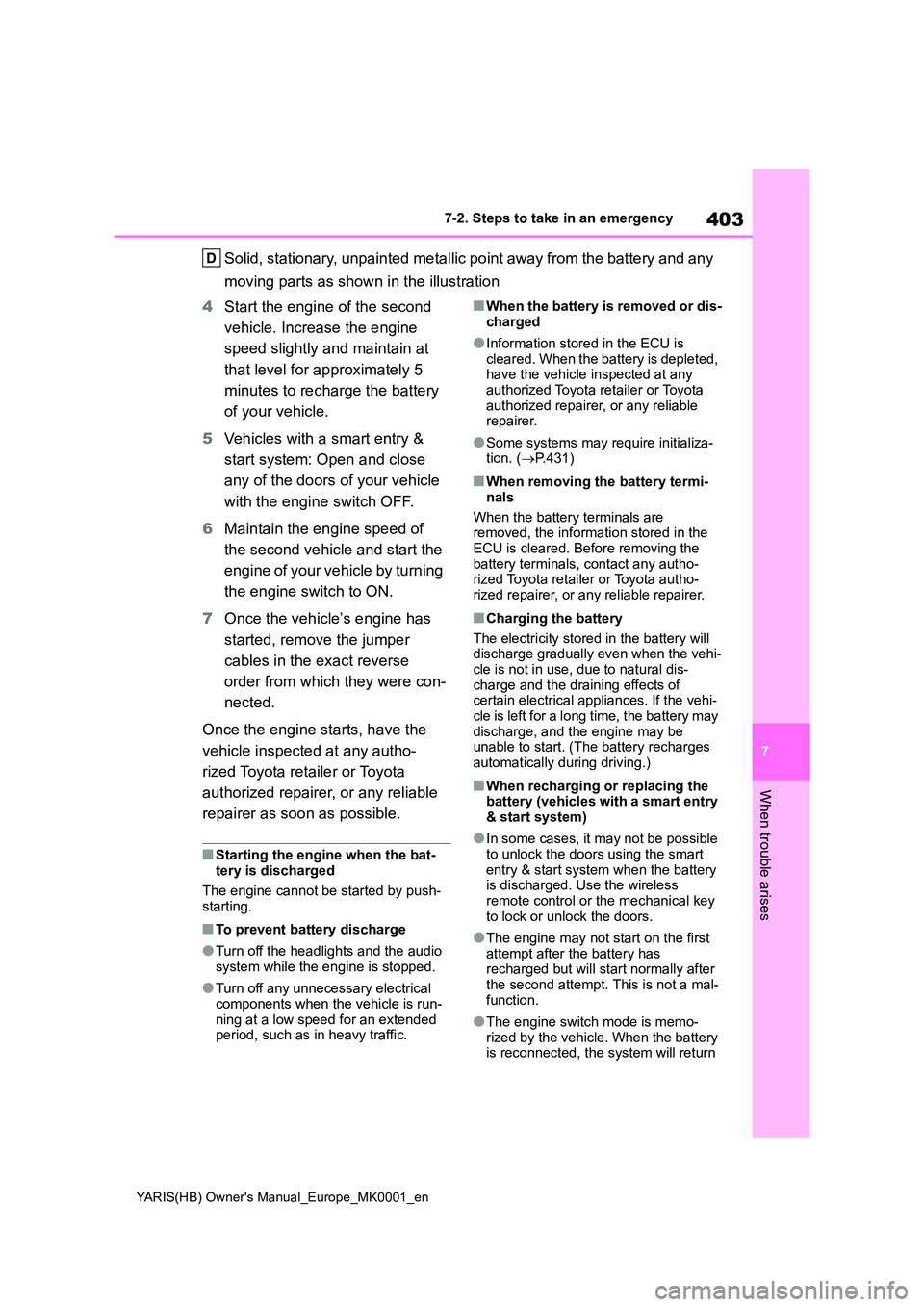
403
7
YARIS(HB) Owner's Manual_Europe_MK0001_en
7-2. Steps to take in an emergency
When trouble arises
Solid, stationary, unpainted metallic point away from the battery and any
moving parts as shown in the illustration
4 Start the engine of the second
vehicle. Increase the engine
speed slightly and maintain at
that level for approximately 5
minutes to recharge the battery
of your vehicle.
5 Vehicles with a smart entry &
start system: Open and close
any of the doors of your vehicle
with the engine switch OFF.
6 Maintain the engine speed of
the second vehicle and start the
engine of your vehicle by turning
the engine switch to ON.
7 Once the vehicle’s engine has
started, remove the jumper
cables in the exact reverse
order from which they were con-
nected.
Once the engine starts, have the
vehicle inspected at any autho-
rized Toyota retailer or Toyota
authorized repairer, or any reliable
repairer as soon as possible.
■Starting the engine when the bat- tery is discharged
The engine cannot be started by push-
starting.
■To prevent battery discharge
●Turn off the headlights and the audio
system while the engine is stopped.
●Turn off any unnecessary electrical
components when the vehicle is run- ning at a low speed for an extended period, such as in heavy traffic.
■When the battery is removed or dis-charged
●Information stored in the ECU is cleared. When the battery is depleted, have the vehicle inspected at any
authorized Toyota retailer or Toyota authorized repairer, or any reliable repairer.
●Some systems may require initializa-tion. ( →P.431)
■When removing the battery termi-
nals
When the battery terminals are removed, the information stored in the
ECU is cleared. Before removing the battery terminals, contact any autho-rized Toyota retailer or Toyota autho-
rized repairer, or any reliable repairer.
■Charging the battery
The electricity stored in the battery will discharge gradually even when the vehi-
cle is not in use, due to natural dis- charge and the draining effects of certain electrical appliances. If the vehi-
cle is left for a long time, the battery may discharge, and the engine may be unable to start. (The battery recharges
automatically during driving.)
■When recharging or replacing the battery (vehicles with a smart entry & start system)
●In some cases, it may not be possible to unlock the doors using the smart
entry & start system when the battery is discharged. Use the wireless remote control or the mechanical key
to lock or unlock the doors.
●The engine may not start on the first
attempt after the battery has recharged but will start normally after the second attempt. This is not a mal-
function.
●The engine switch mode is memo-
rized by the vehicle. When the battery is reconnected, the system will return
Page 404 of 568
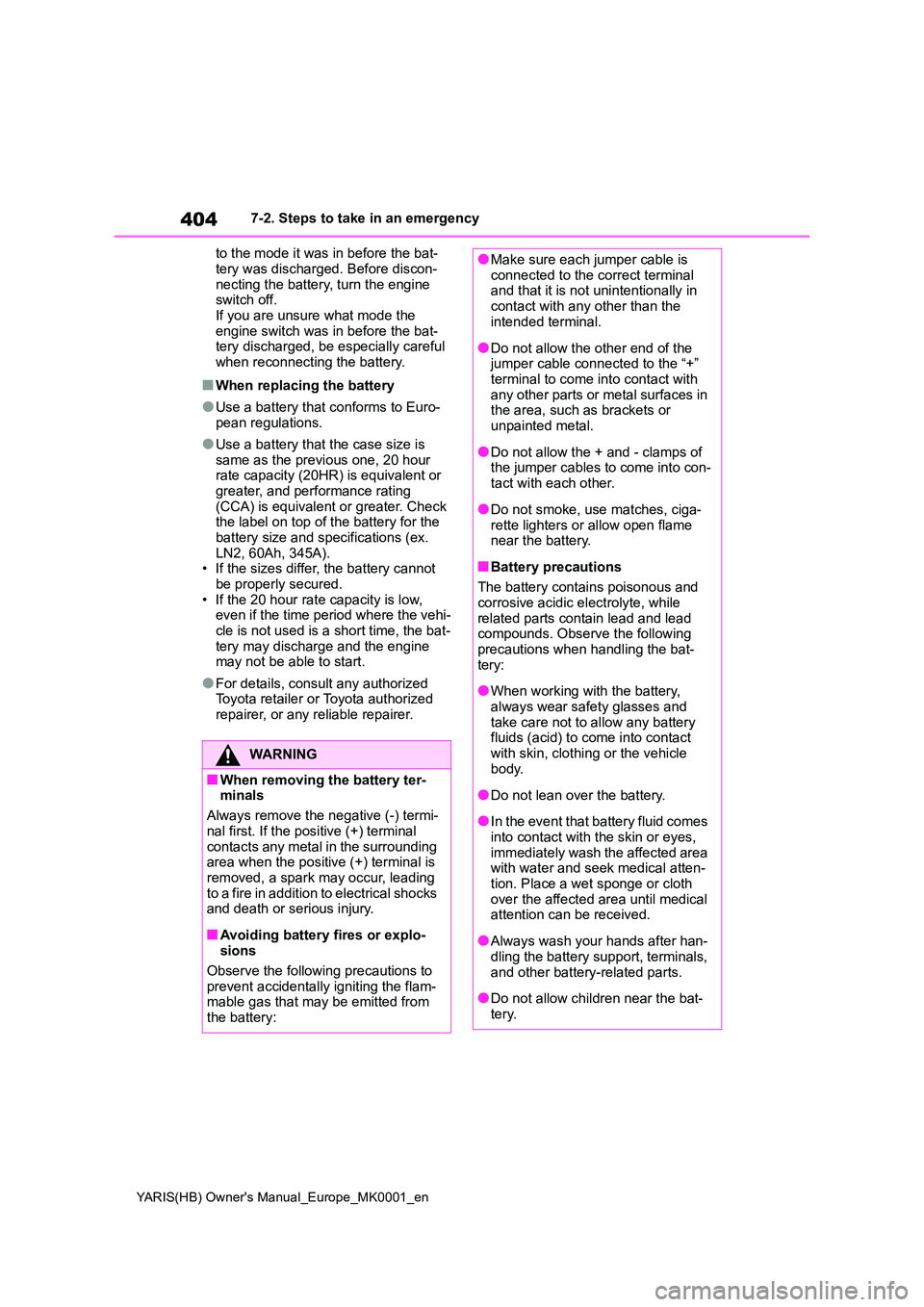
404
YARIS(HB) Owner's Manual_Europe_MK0001_en
7-2. Steps to take in an emergency
to the mode it was in before the bat-
tery was discharged. Before discon- necting the battery, turn the engine switch off.
If you are unsure what mode the engine switch was in before the bat-tery discharged, be especially careful
when reconnecting the battery.
■When replacing the battery
●Use a battery that conforms to Euro-
pean regulations.
●Use a battery that the case size is
same as the previous one, 20 hour rate capacity (20HR) is equivalent or greater, and performance rating
(CCA) is equivalent or greater. Check the label on top of the battery for the battery size and specifications (ex.
LN2, 60Ah, 345A). • If the sizes differ, the battery cannot be properly secured.
• If the 20 hour rate capacity is low, even if the time period where the vehi-cle is not used is a short time, the bat-
tery may discharge and the engine may not be able to start.
●For details, consult any authorized Toyota retailer or Toyota authorized repairer, or any reliable repairer.
WARNING
■When removing the battery ter-minals
Always remove the negative (-) termi-
nal first. If the positive (+) terminal contacts any metal in the surrounding area when the positive (+) terminal is
removed, a spark may occur, leading to a fire in addition to electrical shocks and death or serious injury.
■Avoiding battery fires or explo-sions
Observe the following precautions to prevent accidentally igniting the flam-mable gas that may be emitted from
the battery:
●Make sure each jumper cable is connected to the correct terminal and that it is not unintentionally in
contact with any other than the intended terminal.
●Do not allow the other end of the jumper cable connected to the “+” terminal to come into contact with
any other parts or metal surfaces in the area, such as brackets or unpainted metal.
●Do not allow the + and - clamps of the jumper cables to come into con-
tact with each other.
●Do not smoke, use matches, ciga-
rette lighters or allow open flame near the battery.
■Battery precautions
The battery contains poisonous and corrosive acidic electrolyte, while
related parts contain lead and lead compounds. Observe the following precautions when handling the bat-
tery:
●When working with the battery,
always wear safety glasses and take care not to allow any battery fluids (acid) to come into contact
with skin, clothing or the vehicle body.
●Do not lean over the battery.
●In the event that battery fluid comes
into contact with the skin or eyes, immediately wash the affected area with water and seek medical atten-
tion. Place a wet sponge or cloth over the affected area until medical attention can be received.
●Always wash your hands after han-dling the battery support, terminals,
and other battery-related parts.
●Do not allow children near the bat-
tery.
Page 405 of 568
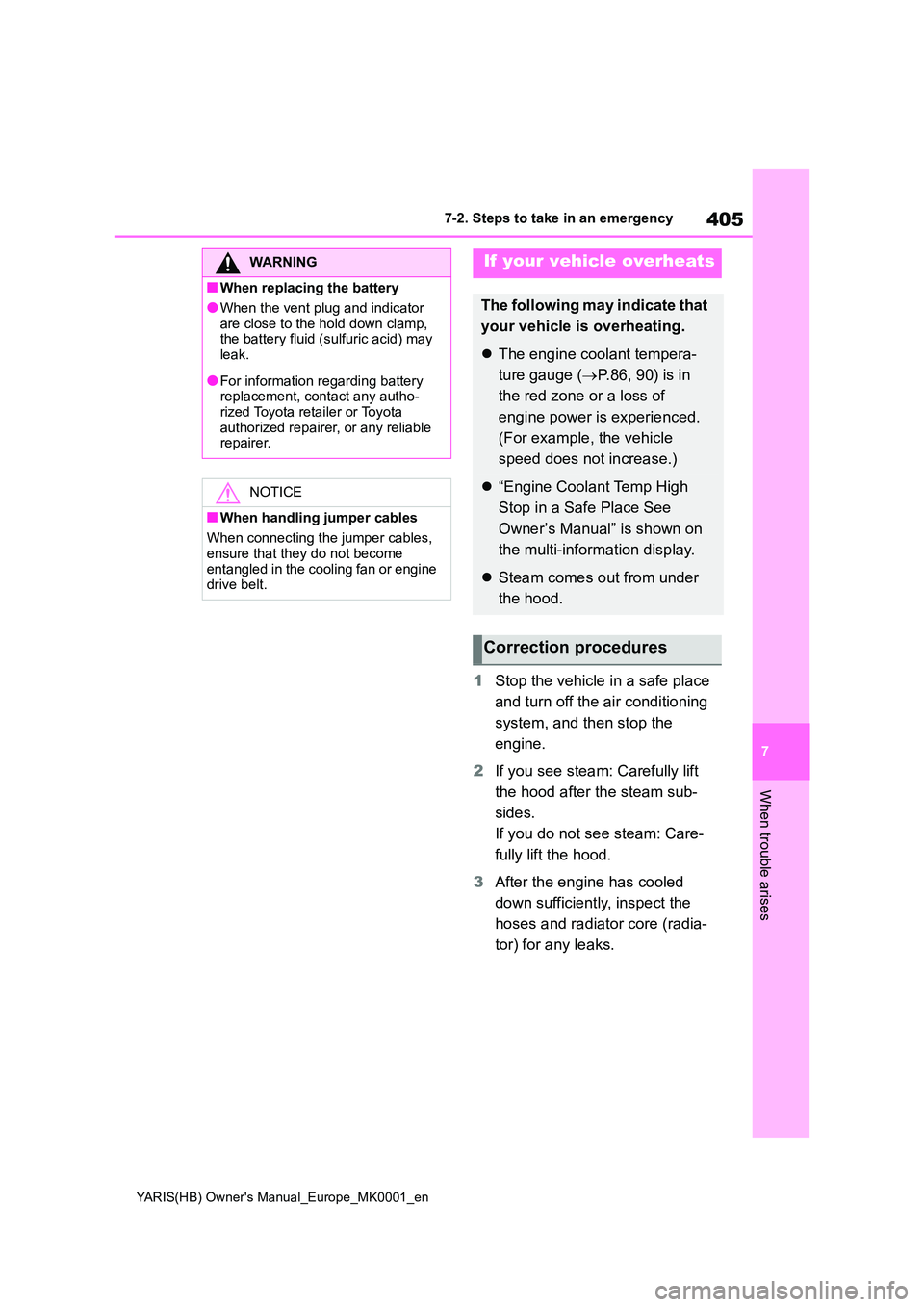
405
7
YARIS(HB) Owner's Manual_Europe_MK0001_en
7-2. Steps to take in an emergency
When trouble arises
1Stop the vehicle in a safe place
and turn off the air conditioning
system, and then stop the
engine.
2 If you see steam: Carefully lift
the hood after the steam sub-
sides.
If you do not see steam: Care-
fully lift the hood.
3 After the engine has cooled
down sufficiently, inspect the
hoses and radiator core (radia-
tor) for any leaks.
WARNING
■When replacing the battery
●When the vent plug and indicator
are close to the hold down clamp, the battery fluid (sulfuric acid) may leak.
●For information regarding battery replacement, contact any autho-
rized Toyota retailer or Toyota authorized repairer, or any reliable repairer.
NOTICE
■When handling jumper cables
When connecting the jumper cables, ensure that they do not become
entangled in the cooling fan or engine drive belt.
If your vehicle overheats
The following may indicate that
your vehicle is overheating.
�z The engine coolant tempera-
ture gauge ( →P.86, 90) is in
the red zone or a loss of
engine power is experienced.
(For example, the vehicle
speed does not increase.)
�z “Engine Coolant Temp High
Stop in a Safe Place See
Owner’s Manual” is shown on
the multi-information display.
�z Steam comes out from under
the hood.
Correction procedures
Page 406 of 568
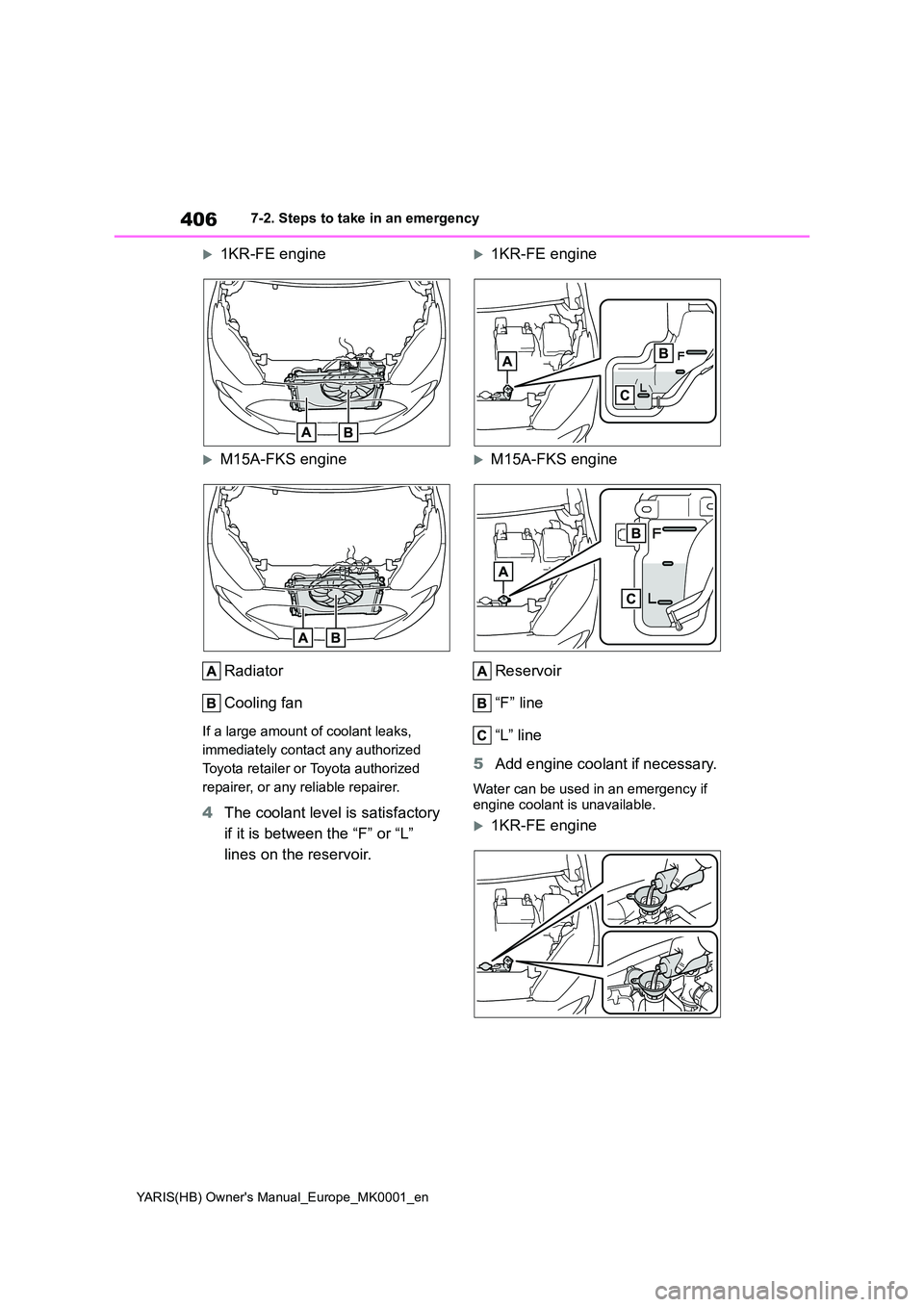
406
YARIS(HB) Owner's Manual_Europe_MK0001_en
7-2. Steps to take in an emergency
1KR-FE engine
M15A-FKS engine
Radiator
Cooling fan
If a large amount of coolant leaks,
immediately contact any authorized
Toyota retailer or Toyota authorized
repairer, or any reliable repairer.
4 The coolant level is satisfactory
if it is between the “F” or “L”
lines on the reservoir.
1KR-FE engine
M15A-FKS engine
Reservoir
“F” line
“L” line
5 Add engine coolant if necessary.
Water can be used in an emergency if engine coolant is unavailable.
1KR-FE engine
Page 407 of 568
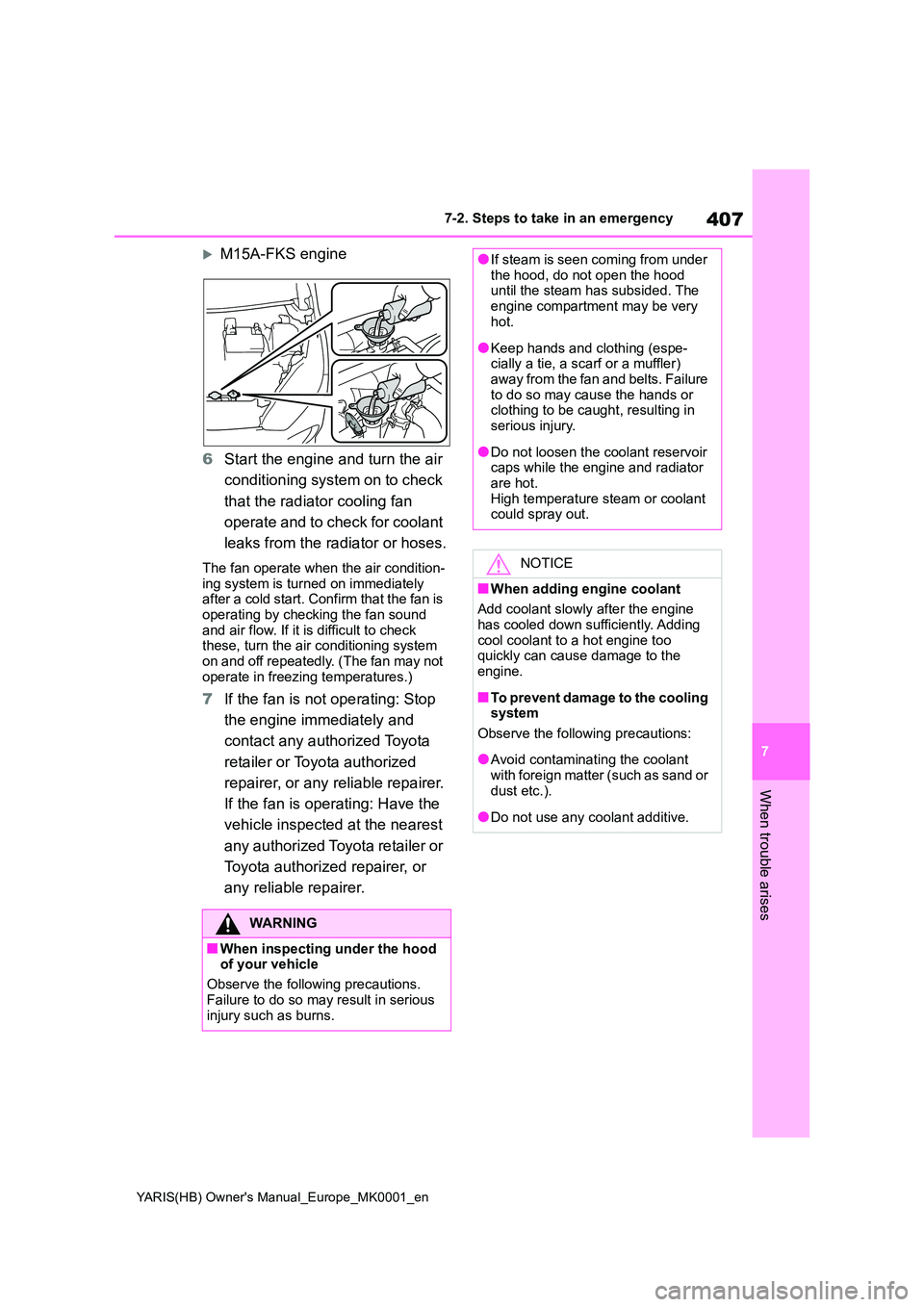
407
7
YARIS(HB) Owner's Manual_Europe_MK0001_en
7-2. Steps to take in an emergency
When trouble arises
M15A-FKS engine
6 Start the engine and turn the air
conditioning system on to check
that the radiator cooling fan
operate and to check for coolant
leaks from the radiator or hoses.
The fan operate when the air condition- ing system is turned on immediately after a cold start. Confirm that the fan is
operating by checking the fan sound and air flow. If it is difficult to check these, turn the air conditioning system
on and off repeatedly. (The fan may not operate in freezing temperatures.)
7 If the fan is not operating: Stop
the engine immediately and
contact any authorized Toyota
retailer or Toyota authorized
repairer, or any reliable repairer.
If the fan is operating: Have the
vehicle inspected at the nearest
any authorized Toyota retailer or
Toyota authorized repairer, or
any reliable repairer.
WARNING
■When inspecting under the hood of your vehicle
Observe the following precautions.
Failure to do so may result in serious injury such as burns.
●If steam is seen coming from under the hood, do not open the hood until the steam has subsided. The
engine compartment may be very hot.
●Keep hands and clothing (espe-cially a tie, a scarf or a muffler) away from the fan and belts. Failure
to do so may cause the hands or clothing to be caught, resulting in serious injury.
●Do not loosen the coolant reservoir caps while the engine and radiator
are hot. High temperature steam or coolant could spray out.
NOTICE
■When adding engine coolant
Add coolant slowly after the engine has cooled down sufficiently. Adding
cool coolant to a hot engine too quickly can cause damage to the engine.
■To prevent damage to the cooling system
Observe the following precautions:
●Avoid contaminating the coolant
with foreign matter (such as sand or dust etc.).
●Do not use any coolant additive.
Page 408 of 568
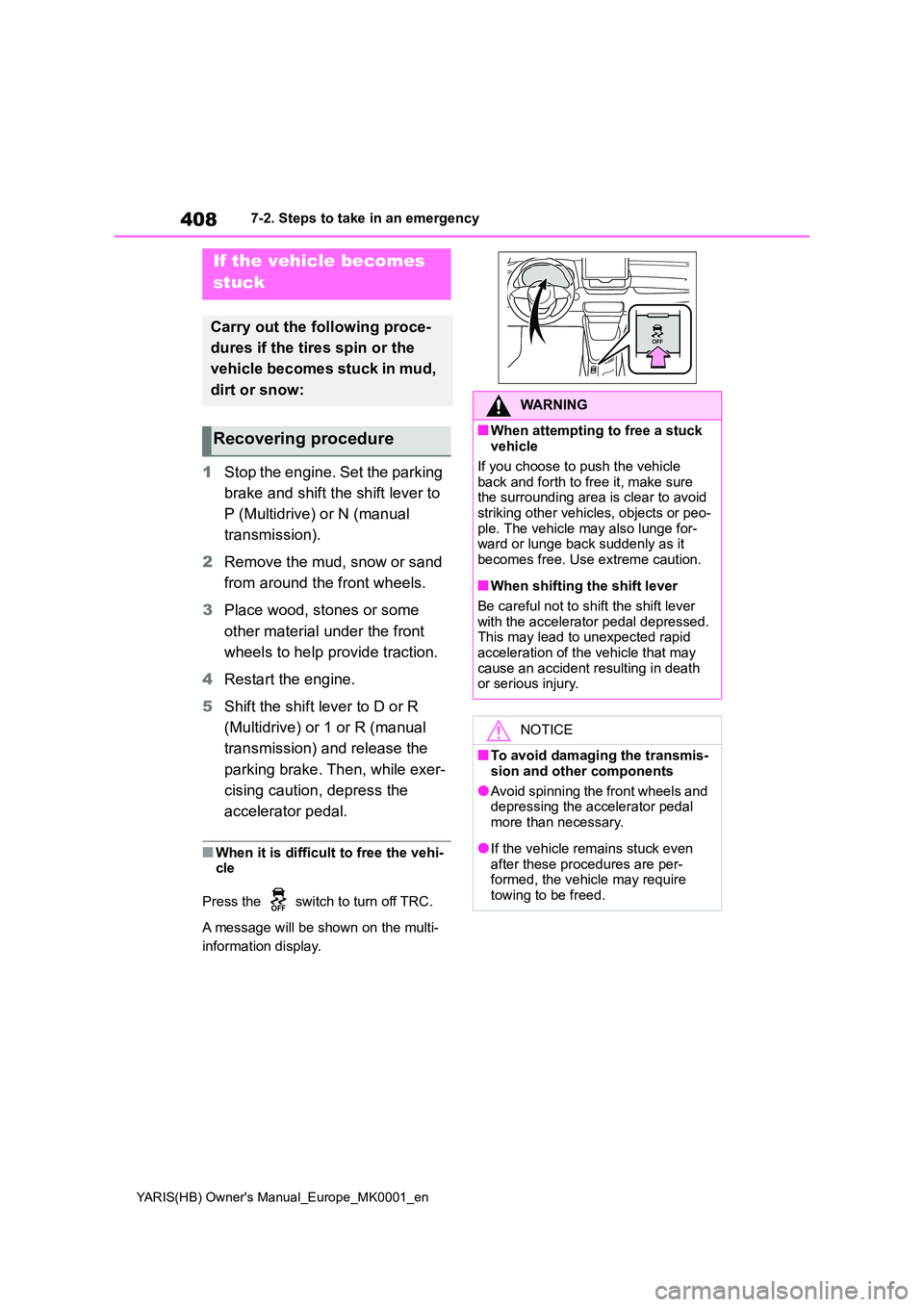
408
YARIS(HB) Owner's Manual_Europe_MK0001_en
7-2. Steps to take in an emergency
1Stop the engine. Set the parking
brake and shift the shift lever to
P (Multidrive) or N (manual
transmission).
2 Remove the mud, snow or sand
from around the front wheels.
3 Place wood, stones or some
other material under the front
wheels to help provide traction.
4 Restart the engine.
5 Shift the shift lever to D or R
(Multidrive) or 1 or R (manual
transmission) and release the
parking brake. Then, while exer-
cising caution, depress the
accelerator pedal.
■When it is difficult to free the vehi- cle
Press the switch to turn off TRC.
A message will be shown on the multi-
information display.
If the vehicle becomes
stuck
Carry out the following proce-
dures if the tires spin or the
vehicle becomes stuck in mud,
dirt or snow:
Recovering procedure
WARNING
■When attempting to free a stuck vehicle
If you choose to push the vehicle back and forth to free it, make sure the surrounding area is clear to avoid
striking other vehicles, objects or peo- ple. The vehicle may also lunge for-ward or lunge back suddenly as it
becomes free. Use extreme caution.
■When shifting the shift lever
Be careful not to shift the shift lever with the accelerator pedal depressed.This may lead to unexpected rapid
acceleration of the vehicle that may cause an accident resulting in death or serious injury.
NOTICE
■To avoid damaging the transmis-
sion and other components
●Avoid spinning the front wheels and depressing the accelerator pedal
more than necessary.
●If the vehicle remains stuck even
after these procedures are per- formed, the vehicle may require towing to be freed.
Page 410 of 568
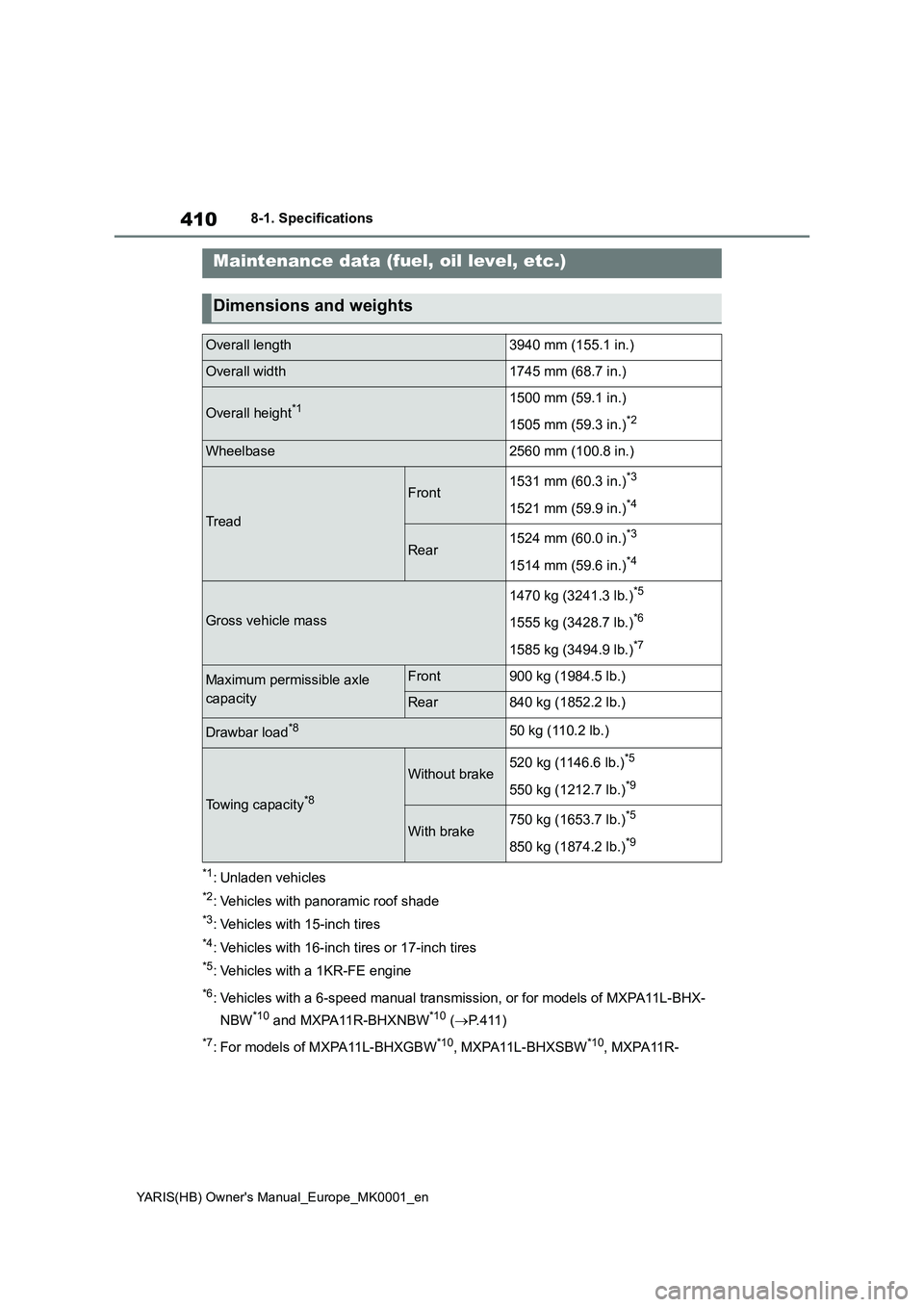
410
YARIS(HB) Owner's Manual_Europe_MK0001_en
8-1. Specifications
8-1.Spec ific ations
*1: Unladen vehicles
*2: Vehicles with panoramic roof shade
*3: Vehicles with 15-inch tires
*4: Vehicles with 16-inch tires or 17-inch tires
*5: Vehicles with a 1KR-FE engine
*6: Vehicles with a 6-speed manual transmission, or for models of MXPA11L-BHX-
NBW
*10 and MXPA11R-BHXNBW*10 (→P. 4 1 1 )
*7: For models of MXPA11L-BHXGBW*10, MXPA11L-BHXSBW*10, MXPA11R-
Maintenance data (fuel, oil level, etc.)
Dimensions and weights
Overall length3940 mm (155.1 in.)
Overall width1745 mm (68.7 in.)
Overall height*11500 mm (59.1 in.)
1505 mm (59.3 in.)
*2
Wheelbase2560 mm (100.8 in.)
Tread
Front1531 mm (60.3 in.)*3
1521 mm (59.9 in.)*4
Rear1524 mm (60.0 in.)*3
1514 mm (59.6 in.)*4
Gross vehicle mass
1470 kg (3241.3 lb.)*5
1555 kg (3428.7 lb.)*6
1585 kg (3494.9 lb.)*7
Maximum permissible axle
capacityFront900 kg (1984.5 lb.)
Rear840 kg (1852.2 lb.)
Drawbar load*850 kg (110.2 lb.)
Towing capacity*8
Without brake520 kg (1146.6 lb.)*5
550 kg (1212.7 lb.)*9
With brake750 kg (1653.7 lb.)*5
850 kg (1874.2 lb.)*9
Page 411 of 568
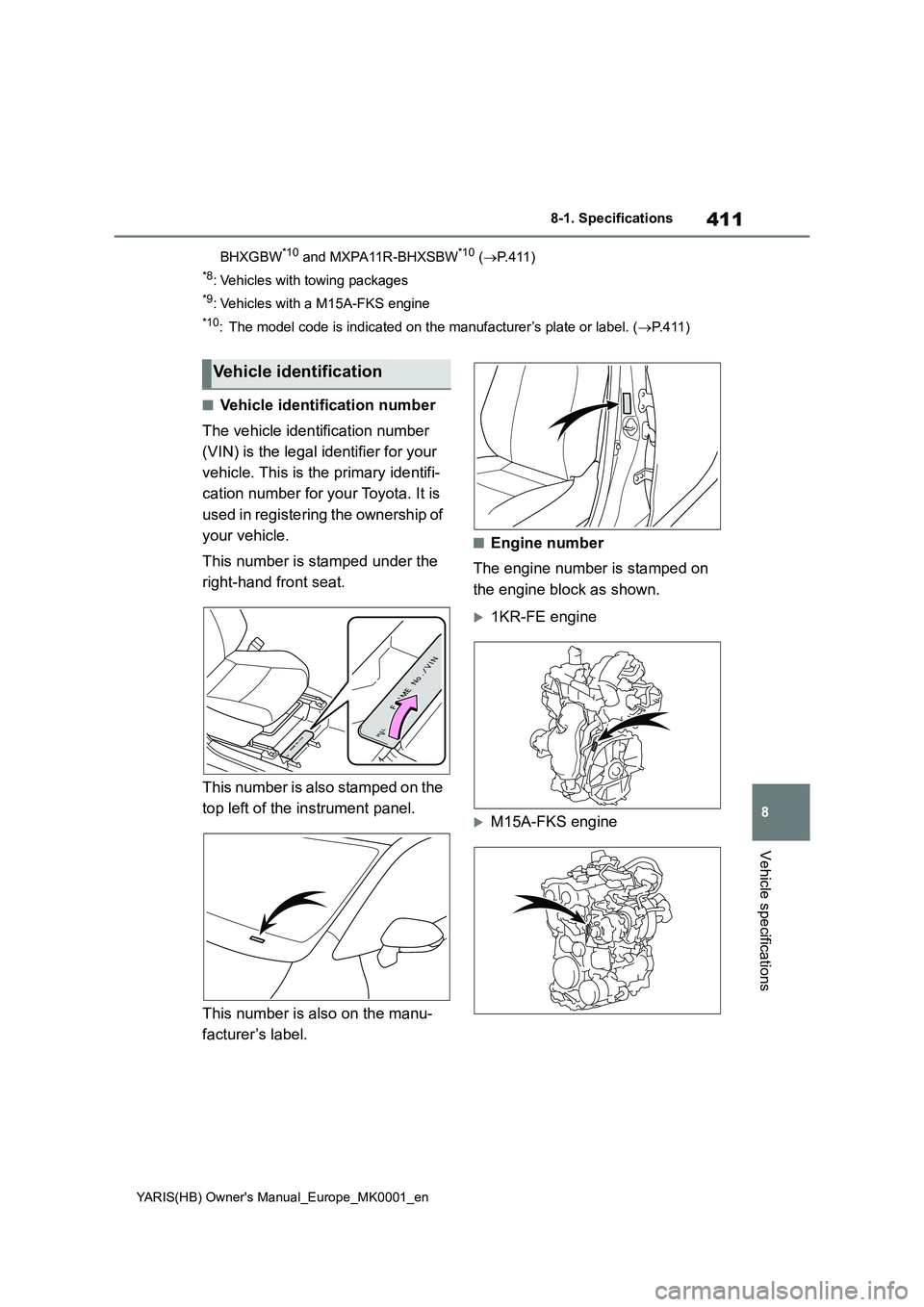
411
8
YARIS(HB) Owner's Manual_Europe_MK0001_en
8-1. Specifications
Vehicle specifications
BHXGBW*10 and MXPA11R-BHXSBW*10 (→P.411)
*8: Vehicles with towing packages
*9: Vehicles with a M15A-FKS engine
*10: The model code is indicated on the manufacturer’s plate or label. (→P. 4 1 1 )
■Vehicle identification number
The vehicle identification number
(VIN) is the legal identifier for your
vehicle. This is the primary identifi-
cation number for your Toyota. It is
used in registering the ownership of
your vehicle.
This number is stamped under the
right-hand front seat.
This number is also stamped on the
top left of the instrument panel.
This number is also on the manu-
facturer’s label.
■Engine number
The engine number is stamped on
the engine block as shown.
1KR-FE engine
M15A-FKS engine
Vehicle identification
Page 412 of 568
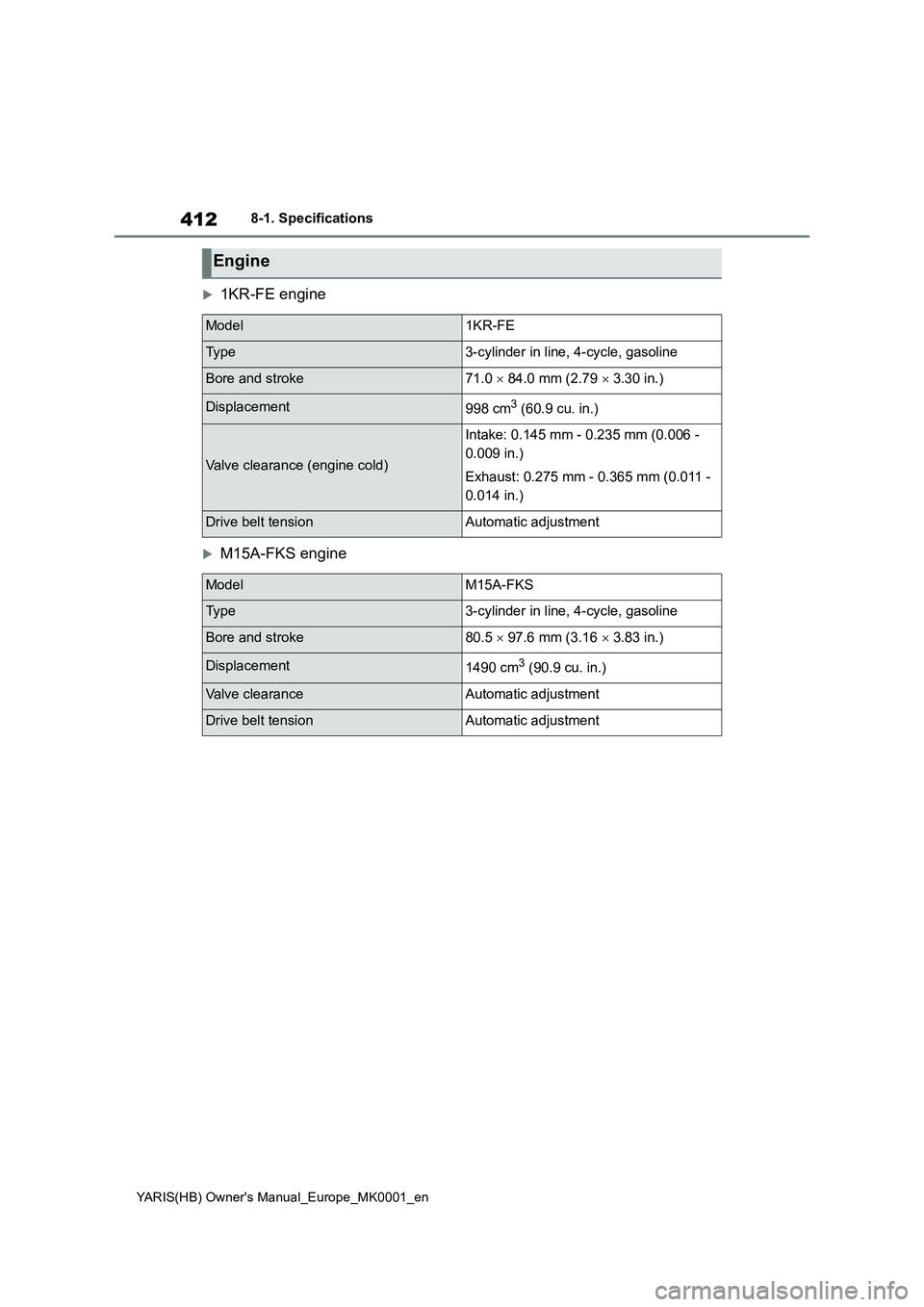
412
YARIS(HB) Owner's Manual_Europe_MK0001_en
8-1. Specifications
1KR-FE engine
M15A-FKS engine
Engine
Model1KR-FE
Ty p e3-cylinder in line, 4-cycle, gasoline
Bore and stroke71.0 × 84.0 mm (2.79 × 3.30 in.)
Displacement998 cm3 (60.9 cu. in.)
Valve clearance (engine cold)
Intake: 0.145 mm - 0.235 mm (0.006 -
0.009 in.)
Exhaust: 0.275 mm - 0.365 mm (0.011 -
0.014 in.)
Drive belt tensionAutomatic adjustment
ModelM15A-FKS
Ty p e3-cylinder in line, 4-cycle, gasoline
Bore and stroke80.5 × 97.6 mm (3.16 × 3.83 in.)
Displacement1490 cm3 (90.9 cu. in.)
Valve clearanceAutomatic adjustment
Drive belt tensionAutomatic adjustment
Page 413 of 568
![TOYOTA YARIS HATCHBACK 2021 Owners Manual 413
8
YARIS(HB) Owners Manual_Europe_MK0001_en
8-1. Specifications
Vehicle specifications
■Oil capacity (Drain and refill
[Reference
*])
*: The engine oil capacity is a reference
quantity to be u TOYOTA YARIS HATCHBACK 2021 Owners Manual 413
8
YARIS(HB) Owners Manual_Europe_MK0001_en
8-1. Specifications
Vehicle specifications
■Oil capacity (Drain and refill
[Reference
*])
*: The engine oil capacity is a reference
quantity to be u](/img/14/68813/w960_68813-412.png)
413
8
YARIS(HB) Owner's Manual_Europe_MK0001_en
8-1. Specifications
Vehicle specifications
■Oil capacity (Drain and refill
[Reference
*])
*: The engine oil capacity is a reference
quantity to be used when changing
the engine oil. Warm up and turn off
the engine, wait more than 5 minutes, and check the oil level on the dip-
stick.
■Engine oil selection
Gasoline Engine ⎯
“Toyota Genuine Motor Oil” is used
in your Toyota vehicle. Toyota rec-
ommends the use of approved
“Toyota Genuine Motor Oil”.
Another motor oil of matching qual-
ity can also be used.
Oil grade:
0W-16:
API grade SN “Resource-Conserv-
ing” or SN PLUS “Resource-Con-
serving” multigrade engine oil
Fuel
Fuel type
When you find these types of fuel label at
the gas station, use only the fuel with one
of the following labels.
EU area:
Unleaded gasoline conforming to Euro-
pean standard EN228 only
Except EU area:
Unleaded gasoline only
Research Octane Number
1KR-FE engine
95 or higher
M15A-FKS engine
95 or higher
Fuel tank capacity
(Reference)
Vehicles without rear wiper
40.0 L (10.6 gal., 8.8 Imp. gal.)
Vehicles with rear wiper
42.0 L (11.1 gal., 9.2 Imp. gal.)
Lubrication system
With filter
1KR-FE engine
2.8 L (3.0 qt., 2.5 Imp. qt.)
M15A-FKS engine
3.4 L (3.6 qt., 3.0 Imp. qt.)
Without fil-
ter
1KR-FE engine
2.5 L (2.6 qt., 2.2 Imp. qt.)
M15A-FKS engine
3.2 L (3.4 qt., 2.8 Imp. qt.)